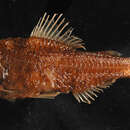pms
nòm ant ël fil


El fanalet de Cocco (Diaphus metopoclampus) és una espècie de peix de la família dels mictòfids i de l'ordre dels mictofiformes.
És depredat per Latimeria chalumnae.[6][7]
Assoleix la maduresa sexual quan arriba als 4,8 cm de longitud.[8]
És un peix marí i d'aigües profundes que viu entre 90-1085 m de fondària.[4][9]
Es troba des de les Illes Britàniques fins a Mauritània[10] (incloent-hi el Mediterrani occidental),[11][12][13] tot i que, de vegades, se n'han capturat exemplars a Libèria i Sud-àfrica. També és present a l'Atlàntic occidental (Estats Units, Brasil i Argentina), l'oest de l'Índic,[14] l'oest del Pacífic (incloent-hi Nova Gal·les del Sud -Austràlia-[15][16] i Nova Zelanda[17]).[4][18]
El fanalet de Cocco (Diaphus metopoclampus) és una espècie de peix de la família dels mictòfids i de l'ordre dels mictofiformes.
Der Punktkopf-Laternenfisch (Diaphus metopoclampus) ist ein kleiner Tiefseefisch, der fast weltweit in tropischen und gemäßigten Meeren vorkommt. Er fehlt lediglich im Indischen Ozean östlich von 70° Geographischer Länge und im östlichen Pazifik. Er kommt auch an der Atlantikküste Europas und im Mittelmeer vor.
Der Punktkopf-Laternenfisch wird 6,5 bis 7,7 cm lang und ist mit 4,8 cm Länge geschlechtsreif. Er hat einen dicken Kopf mit großen Augen und tiefer Maulspalte und einen kurzen, gedrungenen Körper, der seitlich leicht abgeflacht ist und nach hinten spindelförmig zuläuft. Charakteristisches Merkmal der Art sind zwei scheinwerferähnliche, große, fast rechteckige Leuchtorgane, die sich am Vorderkopf zwischen den Augen befinden und sich median berühren. Ausläufer dieser Leuchtorgane erstrecken sich entlang des Unterrandes der Augen. Weitere Leuchtorgane finden sich auf den Flanken unterhalb der Seitenlinie, am Bauch und am Schwanzflossenstiel.
Der Punktkopf-Laternenfisch lebt ozeanisch und mesopelagisch tagsüber in Tiefen von 375 bis 850 Metern (bis 1085 Meter im östlichen Ionischen Meer). Er unternimmt zur Nahrungssuche Vertikalwanderungen und steigt in der Nacht bis auf 90 Meter Wassertiefe auf.
Der Punktkopf-Laternenfisch (Diaphus metopoclampus) ist ein kleiner Tiefseefisch, der fast weltweit in tropischen und gemäßigten Meeren vorkommt. Er fehlt lediglich im Indischen Ozean östlich von 70° Geographischer Länge und im östlichen Pazifik. Er kommt auch an der Atlantikküste Europas und im Mittelmeer vor.
The spothead lantern fish (Diaphus metopoclampus), also called the bluntnose lanternfish,[3] is a species of fish in the family Myctophidae (lanternfish).[4][5]
Its specific name is from Ancient Greek μέτωπον (metōpon, "forehead") and λαμπάς (lampas, "lantern").[6]
The spothead lantern fish is black and pink in colour, with a maximum length of 7.5 cm (3.0 in).[7][8] It has a deep and short head and prominent photophores in its head.[9]
Diaphus metopoclampus is bathypelagic and non-migratory, living at depths of 90–1,085 m (295–3,560 ft) in non-polar seas worldwide, typically on the continental slope.[10][7]
The spothead lantern fish attains sexual maturity at 4.8 cm (1.9 in) in length; it spawns in the spring and summer.[11]
The spothead lantern fish (Diaphus metopoclampus), also called the bluntnose lanternfish, is a species of fish in the family Myctophidae (lanternfish).
Its specific name is from Ancient Greek μέτωπον (metōpon, "forehead") and λαμπάς (lampas, "lantern").
Diaphus metopoclampus Diaphus generoko animalia da. Arrainen barruko Myctophidae familian sailkatzen da.
Espezie hau honako ekosistematan aurki daiteke:
Diaphus metopoclampus Diaphus generoko animalia da. Arrainen barruko Myctophidae familian sailkatzen da.
Il muso lucente (Diaphus metopoclampus) è un pesce abissale della famiglia Myctophidae.
È presente nella fascia subtropicale dell'Oceano Atlantico e nel mar Mediterraneo. Nei mari italiani sembra rara, segnalata solo nel mar Tirreno, in Sardegna ed anche nello stretto di Messina, dove spiaggia di rado, in primavera ed in autunno.
Vive almeno fino ad 800 m di profondità ed ha abitudini pelagiche.
Anche se, come in tutti i pesci lanterna per una corretta identificazione si devono osservare i caratteri dei fotofori, questa specie appare caratteristica per la grande testa e la sagoma tozza. Sul muso è presente un grande fotoforo a forma di mezzaluna, formato dai Dn e dai Vn fusi assieme, che lo rende assolutamente inconfondibile. Questo organo luminoso si estende anche sotto il grande occhio. Non ci sono ghiandole luminose sul peduncolo caudale. I fotofori sono divisi in due parti uguali da un setto nero.
Il colore è blu-nero con riflessi metallici, gli occhi sono verdi ed il grande fotoforo frontale è biancastro. Può raggiungere i 10 cm.
Si ciba di piccoli crostacei planctonici.
Casuale con reti a strascico pelagiche. Non viene venduta sui mercati.
Il muso lucente (Diaphus metopoclampus) è un pesce abissale della famiglia Myctophidae.
Diaphus metopoclampus is een straalvinnige vissensoort uit de familie van lantaarnvissen (Myctophidae).[1] De wetenschappelijke naam van de soort is voor het eerst geldig gepubliceerd in 1829 door Cocco.
Bronnen, noten en/of referenties高體眶灯鱼(学名:Diaphus metopoclampus)为輻鰭魚綱燈籠魚目灯笼鱼科的其中一種,分布於全球三大洋熱帶及亞熱帶海域,屬深海魚類,棲息深度90-1085公尺,體長可達7.5公分。